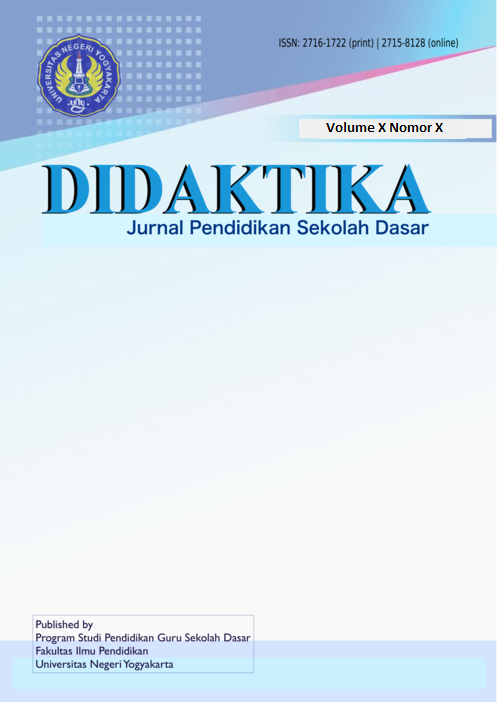Rancang Cipta Lagu Anak-Anak Berbasis Karakter Nilai Kesantunan
DOI:
https://doi.org/10.21831/didaktika.v2i1.28095Abstract
The phenomenon of children's song crises, especially those based on the values of politeness, is an important issue that must be addressed wisely. Children's songs are rarely taught at school because children feel bored with the songs that have been delivered when in kindergarten. This causes children to tend to prefer adult songs which, of course, are inadequate for the mental maturity conditions of children. Adult songs, whether they are pop, rock, metal, or dangdut lack the modesty characters needed by children because they are not consumed by children. Charity value characters have not been optimized such as greeting, excuse me, please, apologize, and thank you. This problem is a challenge in the design and creation of children's songs based on politeness values. Song copyright design has stages of identification, design, manufacture, recording, and feasibility testing. The song creation is expected to be one of the modification of the results of the theme of politeness and make it a habit of modesty.
References
Al-Qahthani, Said bin Ali bin Wahf. (2013). Paduan Lengkap Tarbiyatul Aulad. Solo: Zamzam.
Alwi, Tantowi. (2017). Indonesia Krisis Lagu Anak, Jadi Kompas Gramedia Gelar Dendang Kencana 2017. (online) Tersedia:http://jogja.tribunnews.com/2017/11/17/indonesia-krisis-lagu-anak-jadi-alasan-kompas-gramedia-gelar-dendang-kencana-2017.
Anam, Athfalul. (2011). Kesantunan Berbahasa dalam Buku Ajar Bahasa Indonesia Tataran Unggul: untuk SMK dan MAK Kelas XII Karangan Yustinah dan Ahmad Iskak. Skripsi. Yogyakarta:Universitas Negeri Yogyakarta.
Bakri. (2016). Bahasa dan Kesantunan. (online). Tersedia:http://aceh.tribunnews.com /2016/10/09/ bahasa-dan-kesantunan.
Banoe, Pono. (2003). Kamus Musik. Yogyakarta:Kanisius.
Baswedan, Anis. (2016). Pidato Menteri Pendidikan dan Kebudayaan RI. Pada Hari Pendidikan 02 Mei 2016.
Burge, David. (1990). Twentieth-Century Piano Music. New York: Schirmer Books.
Chaer, Abdul. (2010). Kesantunan Berbahasa. Jakarta:Rineka Cipta.
Cook, Nicholas. (1987). A Guide to Musical Analysis. New York: W.W Norton and Company Disagreements. International Journal of Social and Humanity, Vol.2, No.2, March 2012.
Fajar, Indah. (1996). Pragmatik. Yogyakarta:Pustaka Pelajar.
Gillespie, John. (1965). Five Centuries of Keyboard Music. California: Wadsworth Publishing Company.
Hoffer, Charles. (2013). Music Listening Today:Advantage Edition. Stanford:Cengage Learning.
Ivanchenko, Oleksii. (2015). Characteristics of Maurice Ravel's Compositional Language as Seen Through the Texture of His Selected Piano Works and the Piano Suite "Gaspard
Jamalus. (1981). Musik 4 untuk PSG. Jakarta: Departemen Pendidikan dan Kebudayaan.
Kaminsky, Peter. (2011). Unmasking Ravel: New Perspective on the Music. New York: University Rochester Press.
Kemendiknas RI. (2011). Pengembangan Pendidikan Budaya dan Karakter Bangsa: Pedoman Sekolah. Jakarta: Badan Penelitian dan Pengembangan, Pusat Kurikulum Depdiknas RI.
Keraf, Gorys. (2006). Diksi dan Gaya Bahasa. Jakarta:PT Gramedia.
Kodijat, Latifah. (1986). Istilah-istilah Musik. Jakarta:Djambatan.
Kurniawati. (2017). Transactional Speech as s Learned Product and Part of Introduction Indonesian as the Second Language in Al-Hijaz Province. Makalah pada 2 ndInternational Conference on Primary and Early Childhood Education.
Linggono,B. (1983). Bentuk dan Analisis Musik. Yogyakarta:Pusat Musik Liturgi.
Mack, Dieter. (1995). Sejarah Musik Jilid 3. Yogyakarta:Pusat Musik Liturgi.
Marshall dan Rossman. (2007). Designing Qualitative Research. London: Sage Publication.
Martin, William R dan Drossin, Julius. (1980). Music of the Twentieth Century. Englewood
Clifrs: Prentice-Hall, Inc.
Milles, WB dan AM. Huberman.(1992). Qualitative Data Analysis: a Source Book of New Methode. Beverly Hills:Sage.
Muharram, Halid Muhammad. (2006). Al-Tarbiyah Al-Islamiyah Lil Awlad. Beirut: Dar Al- Kotob Al-Ilmiyah.
Oreinstein, Arbie. (1991). Ravel:Man and Musician. New York: Dover Publication Inc.
Ottmanm Robetrt W. (1962). Elementary Harmony Theory and Practice. Engelwood Cliff, N.J:Prentice-Hall, Inc.
Prier, SJ. (2011). Ilmu Bentuk Analisis. Yogyakarta:Pusat Musik Liturgi.
Ratnawati, Erna. (2012). Respon Verbal Peserta Didik SMP terhadap Jenis, Fungsi, dan Kesantunan Tuturan Guru Bahasa Indonesia di dalam Interaksi Pembelajaran. Jurnal Seloka: Unnes. Vol. 1 No.2 tahun 2012.
Robert, Schmitz.(1950). The Piano Works of Claude Debussy. Edited and Designed by Merle Armitage. New York: Duell, Sloan & Pearce, Inc.
Salirawati, Das.(2012). Percaya Diri, Keingintahuan, dan Berjiwa Wirausaha Tiga Karakter Penting bagi Peserta Didik. Jurnal Pendidikan Karakter.II 92, hlm.1-12. Artikel diakses pada tanggal 15 November 2017, di situs Journal.uny.ac.id/index.php.jpka
Sauri, Sofyan. (2017). Kesantunan Berbahasa. Bandung: Royan Press.
Stein, Leon. (1979). Structure and Style. The Study of Analysis of Musical Form. Princenton, New Jersey: Summy-Birchard Music.
Sugiyono. (2007). Metode Penelitian Kualitatif dan R&D. Bandung:CV Alfa Beta.
TIM DEPDIKBUD. (1988). Pengajaran Musik untuk melalui Pengalaman Musik. Jakarta: Departemen Pendidikan dan Kebudayaan.
Tim.(1996). Ilmu Melodi. Yogyakarta: Pusat Musik Liturgi.
Downloads
Published
How to Cite
Issue
Section
Citation Check
License
- Authors retain copyright and grant the journal right of first publication with the work simultaneously licensed under a Creative Commons Attribution License that allows others to share the work with an acknowledgement of the work's authorship and initial publication in this journal.
- Authors are able to enter into separate, additional contractual arrangements for the non-exclusive distribution of the journal's published version of the work (e.g., post it to an institutional repository or publish it in a book), with an acknowledgement of its initial publication in this journal.
- Authors are permitted and encouraged to post their work online (e.g., in institutional repositories or on their website) prior to and during the submission process, as it can lead to productive exchanges, as well as earlier and greater citation of published work.






